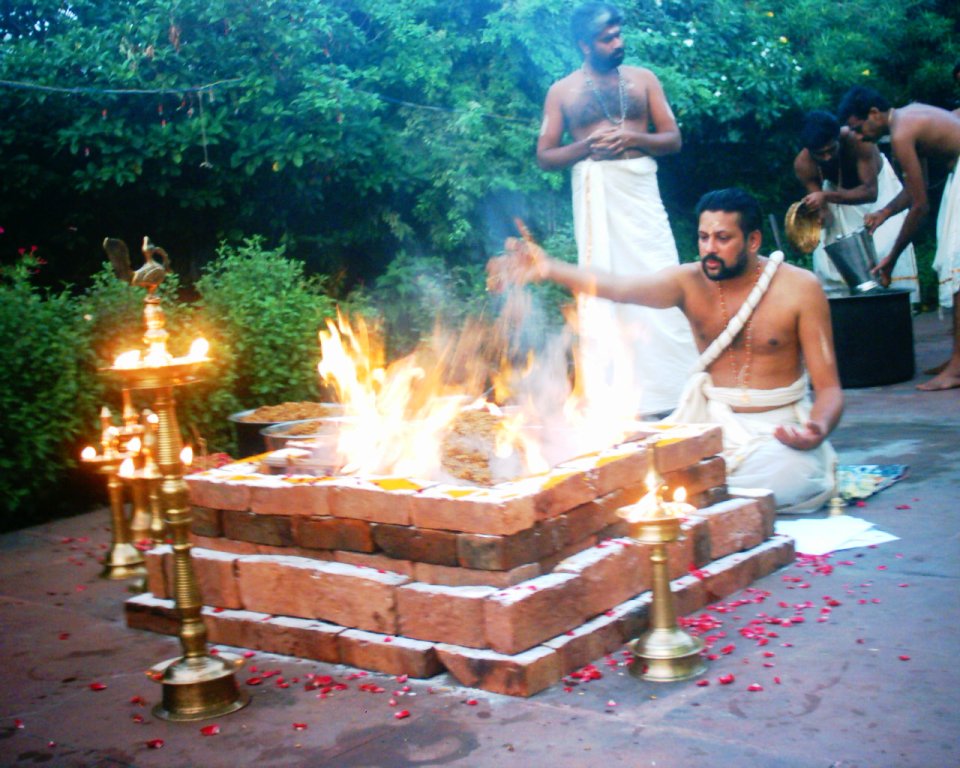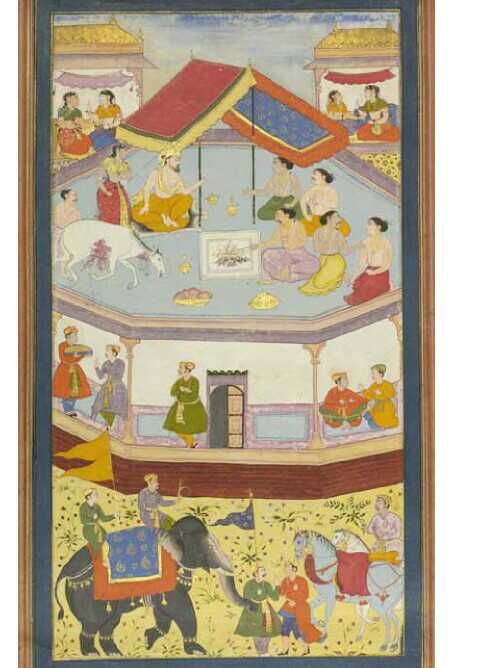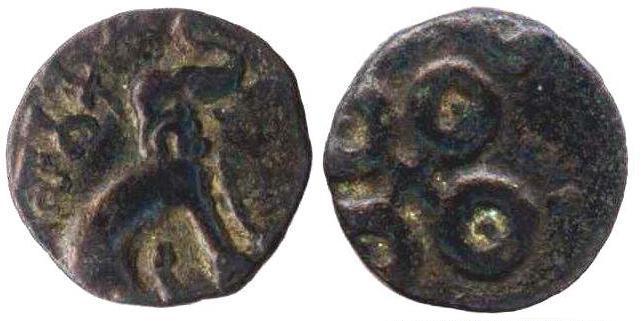|
Rajasuya
Rajasuya () is a śrauta ritual of the Vedic religion. It is ceremony that marks a consecration of a king. According to the Puranas, it refers to a great sacrifice performed by a Chakravarti – universal monarch, in which the tributary princes may also take part, at the time of his coronation, as a mark of his undisputed sovereignty. Description The rajasuya is associated with the consecration of a king and is prescribed as a ritual to establish a king's sovereignty. It is described in the Taittiriya corpus, including Apastamba '' Śrauta Sutra'' 18.8–25.22. It involves '' soma'' pressing, a chariot drive, the king shooting arrows from his bow, and a symbolic "cattle raid": The newly anointed king seizes cattle belonging to his relative, and then gives part of his property to that relative. Also included is a game of throwing dice with the Adhvaryu priest in which the king wins a cow, by which the king is enthroned and the cosmos is regenerated. There is a revealing of the ta ... [...More Info...] [...Related Items...] OR: [Wikipedia] [Google] [Baidu] |
Shunahshepa
Shunahshepa () is a legendary sage mentioned in Hindu mythology. A number of passages in ''Rigveda'' are attributed to him. He was adopted by the sage Vishvamitra, and given the new name Devarata. His name is also transliterated as Cunahcepa, Cunahçepa, Sunahsephas, Sunahshepa, and Shunashepa. He was first mentioned in Mandala 1, Hymn 24 of the Rigveda as a devotee of the god Varuna. According to a legend, Shunahshepa was chosen to be sacrificed in a ritual, but was saved after praying to the Rigvedic deities. The earliest extant text to mention this legend is '' Aitareya Brahmana'' (7.13-18) of ''Rigveda''. The story is repeated in the '' Balakanda'' (1.61) of Valmiki's ''Ramayana'' with some variations. Several other texts borrow the story: these include ''Sankhyana Srauta Sutra'', ''Baudhayana Shrauta Sutra'', the Puranas, and the works of Chandrakirti among others. Legend Aitareya Brahmana King Harishchandra of the Ikshvaku dynasty had 100 wives, but no son. On ... [...More Info...] [...Related Items...] OR: [Wikipedia] [Google] [Baidu] |
Shatapatha Brahmana
The Shatapatha Brahmana (, , abbreviated to 'SB') is a commentary on the Yajurveda, Śukla Yajurveda. It is attributed to the Vedic sage Yajnavalkya. Described as the most complete, systematic, and important of the Brahmanas (commentaries on the Vedas), it contains detailed explanations of Historical Vedic religion, Vedic Yajna, sacrificial rituals, symbolism, and mythology. Particularly in its description of sacrificial rituals (including construction of complex fire-altars). The Shatapatha Brahmana is also considered significant in the development of Vaishnavism as the origin of several Puranas, Puranic legends and avatars of Vishnu. Notably, all of them (Matsya, Kurma, Varaha, Narasimha, and Vamana) are listed as the first five avatars in the Dashavatara (the ten principal avatars of Vishnu). There are two versions (recensions) available of this text. They are the Madhyandina Shakha, Madhyandina recension and the Kanva Shakha, Kanva recension. This article focuses exclusively ... [...More Info...] [...Related Items...] OR: [Wikipedia] [Google] [Baidu] |
Historical Vedic Religion
The historical Vedic religion, also called Vedism or Brahmanism, and sometimes ancient Hinduism or Vedic Hinduism, constituted the religious ideas and practices prevalent amongst some of the Indo-Aryan peoples of the northwest Indian subcontinent (Punjab and the western Ganges plain) during the Vedic period ( 1500–500 BCE). These ideas and practices are found in the Vedic texts, and some Vedic rituals are still practised today. The Vedic religion is one of the major traditions which Origins of Hinduism, shaped modern Hinduism, though present-day Hinduism is significantly different from the historical Vedic religion. The Vedic religion has roots in the Indo-Iranians, Indo-Iranian culture and religion of the Sintashta culture, Sintashta ( 2200–1750 BCE) and Andronovo culture, Andronovo ( 2000–1150 BCE) cultures of Eurasian Steppe. This Indo-Iranian religion borrowed "distinctive religious beliefs and practices" from the non-Indo-Aryan Bactria–Margiana Archaeological Compl ... [...More Info...] [...Related Items...] OR: [Wikipedia] [Google] [Baidu] |
Mahabharata
The ''Mahābhārata'' ( ; , , ) is one of the two major Sanskrit Indian epic poetry, epics of ancient India revered as Smriti texts in Hinduism, the other being the ''Ramayana, Rāmāyaṇa''. It narrates the events and aftermath of the Kurukshetra War, a war of succession between two groups of princely cousins, the Kauravas and the Pandava, Pāṇḍavas. It also contains Hindu philosophy, philosophical and devotional material, such as a discussion of the four "goals of life" or ''puruṣārtha'' (12.161). Among the principal works and stories in the ''Mahābhārata'' are the ''Bhagavad Gita'', the story of Damayanti, the story of Shakuntala, the story of Pururava and Urvashi, the story of Savitri and Satyavan, the story of Kacha (sage), Kacha and Devayani, the story of Rishyasringa and an Ramopakhyana, abbreviated version of the ''Rāmāyaṇa'', often considered as works in their own right. Traditionally, the authorship of the ''Mahābhārata'' is attributed to Vyasa, Vy ... [...More Info...] [...Related Items...] OR: [Wikipedia] [Google] [Baidu] |
śrauta
Śrauta (Sanskrit: श्रौत) is a Sanskrit word that means "belonging to śruti", that is, anything based on the Vedas of Hinduism. It is an adjective and prefix for texts, ceremonies or person associated with śruti. The term, for example, refers to Brahmins who specialise in the ''śruti'' corpus of texts, and Śrauta Brahmin traditions in modern times can be seen in Kerala and Coastal Andhra. Etymology and meaning The Sanskrit word ''śrauta'' is rooted in ''śruti'' ("that which is heard", referring to scriptures of Hinduism). Johnson says that ''śrauta'', is an adjective that is applied to a text, a ritual practice, or a person, that is associated with ''śruti''. Klostermaier concurs, stating that the prefix means "belonging to ''śruti''", and includes ceremonies and texts related to ''śruti''. The word is sometimes spelled ''shrauta'' in scholarly literature. History Spread via Indian religions, homa traditions are found all across Asia, from Samarkand to Japan, ... [...More Info...] [...Related Items...] OR: [Wikipedia] [Google] [Baidu] |
Rājyābhiṣeka
The rājyābhiṣeka is a late Vedic ceremony of coronation. It also refers to anointing government officials, particularly heads of state, at the time of taking power or to mark a signal achievement. See also *Abhiṣeka *Rajasuya * Coronation of the Burmese monarch *Coronation of the Nepalese monarch *Coronation of the Thai monarch The coronation of the monarch of Thailand is a ceremony in which they are formally consecrated by Anointing, anointment and Coronation, crowning. The ceremony is divided into two main events: the coronation rites and the celebration of the Assum ... References {{Reflist Vedic customs Coronation Ceremonies in India Indian monarchs Indian royalty ... [...More Info...] [...Related Items...] OR: [Wikipedia] [Google] [Baidu] |
Ashvamedha
The Ashvamedha () was a horse sacrifice ritual followed by the Śrauta tradition of Vedic religion. It was used by ancient Indian kings to prove their imperial sovereignty: a horse accompanied by the king's warriors would be released to wander for a year. In the territory traversed by the horse, any rival could dispute the king's authority by challenging the warriors accompanying it. After one year, if no enemy had managed to kill or capture the horse, the animal would be guided back to the king's capital. It would be then sacrificed, and the king would be declared as an undisputed sovereign. The ritual is recorded as being held by many ancient rulers, but apparently only by two in the last thousand years. The most recent ritual was in 1741, the second one held by Maharajah Jai Singh II of Jaipur. The original Vedic religion had evidently included many animal sacrifices, as had the various folk religions of India. Brahminical Hinduism had evolved opposing animal sacrifices, ... [...More Info...] [...Related Items...] OR: [Wikipedia] [Google] [Baidu] |
Kharavela
Kharavela was the emperor of Kalinga (present-day eastern coast of India) in the 2nd or 1st century BC. The primary source for Kharavela is his rock-cut Hathigumpha inscription. The inscription is undated, only four of its 17 lines are completely legible, others unclear, variously interpreted and disputed by scholars. The inscription written with Jainism-related phrases recites a year by year record of his reign and panegyrically credits him with public infrastructure projects, welfare activities, patronage of the arts, and many military victories. Historians agree that it is best and most complete biography of Kharavela available. He was a follower of Jainism. Background Sources Much of the available information about Kharavela comes from the undated, much damaged Hathigumpha inscription and several minor inscriptions found in the Udayagiri and Khandagiri Caves in present-day Odisha. The Hathigumpha inscription records Kharavela's life until his 38th year, including 13 ... [...More Info...] [...Related Items...] OR: [Wikipedia] [Google] [Baidu] |
Varuna
Varuna (; , ) is a Hindu god. He is one of the earliest deities in pantheon, whose role underwent a significant transformation from the Vedic to the Puranic periods. In the early Vedic era, Varuna is seen as the god-sovereign, ruling the sky and embodying divine authority. He is also mentioned as the king of asuras, who gained the status of a deva, serving as the chief of the Adityas, a group of celestial deities. He maintains truth and ''ṛta'', the cosmic and moral order, and was invoked as an omniscient ethical judge, with the stars symbolizing his watchful eyes or spies. Frequently paired with Mitra, Varuna represents the magical and speculative aspects of sovereignty, overseeing the relationship between gods and humans. The transition from the Vedic to later periods saw Varuna's domain begin to shift from the firmament to waters. He became associated with celestial waters, marking the initial phase of his transformation. By the time of the '' Itihasa-Purana'', Varuna ha ... [...More Info...] [...Related Items...] OR: [Wikipedia] [Google] [Baidu] |
Satavahana Dynasty
The Satavahanas (; ''Sādavāhana'' or ''Sātavāhana'', IAST: ), also referred to as the Andhras (also ''Andhra-bhṛtyas'' or ''Andhra-jatiyas'') in the Puranas, were an ancient Indian dynasty. Most modern scholars believe that the Satavahana rule began in the late 2nd century BCE and lasted until the early 3rd century CE, although some assign the beginning of their rule to as early as the 3rd century BCE based on the Puranas, but uncorroborated by archaeological evidence. The Satavahana kingdom mainly comprised the present-day Andhra Pradesh, Telangana, and Maharashtra. At different times, their rule extended to parts of modern Gujarat, Madhya Pradesh, and Karnataka. The dynasty had different capital cities at different times, including Pratishthana (Paithan) and Amaravati ( Dharanikota). The origin of the dynasty is uncertain, but according to the Puranas, their first king overthrew the Kanva dynasty. In the post-Maurya era, the Satavahanas established peace in the Decca ... [...More Info...] [...Related Items...] OR: [Wikipedia] [Google] [Baidu] |
Jainism
Jainism ( ), also known as Jain Dharma, is an Indian religions, Indian religion whose three main pillars are nonviolence (), asceticism (), and a rejection of all simplistic and one-sided views of truth and reality (). Jainism traces its spiritual ideas and history through the succession of twenty-four , supreme preachers of ''dharma''. The first in the current time cycle is Rishabhadeva, who tradition holds lived millions of years ago; the 23rd is Parshvanatha, traditionally dated to the 9th century Common Era, BCE; and the 24th is Mahāvīra, Mahavira, who lived . Jainism is considered an eternal ''dharma'' with the guiding every time cycle of the Jain cosmology, cosmology. Central to understanding Jain philosophy is the concept of ''bhedavijñāna'', or the clear distinction in the nature of the soul and non-soul entities. This principle underscores the innate purity and potential for liberation within every Jīva (Jainism), soul, distinct from the physical and menta ... [...More Info...] [...Related Items...] OR: [Wikipedia] [Google] [Baidu] |








